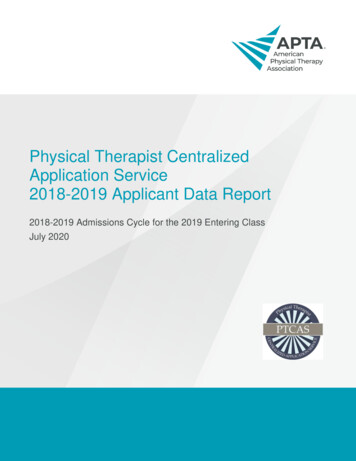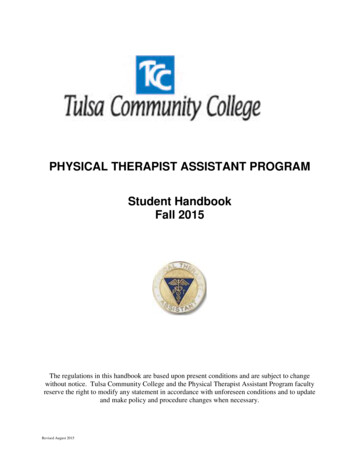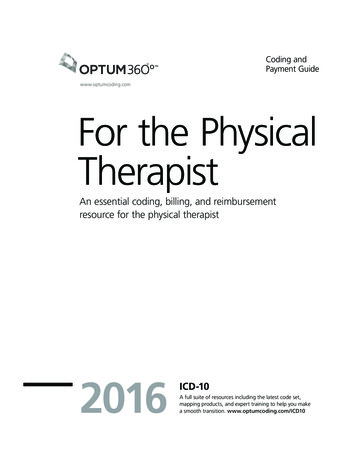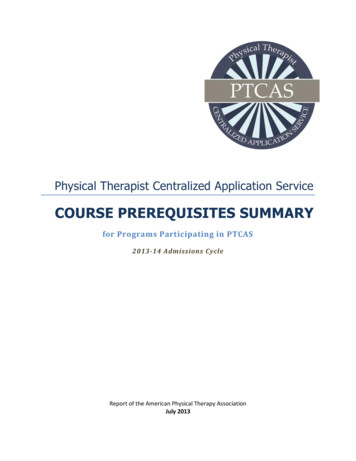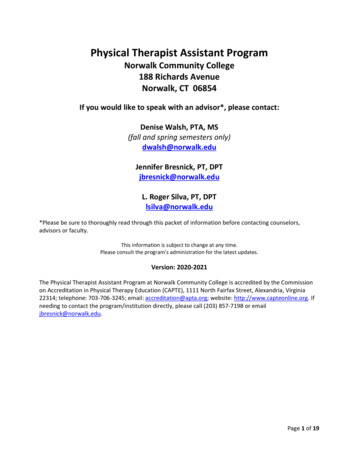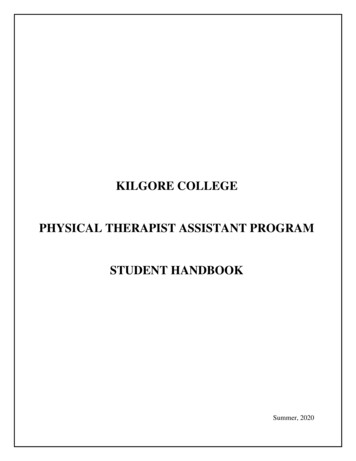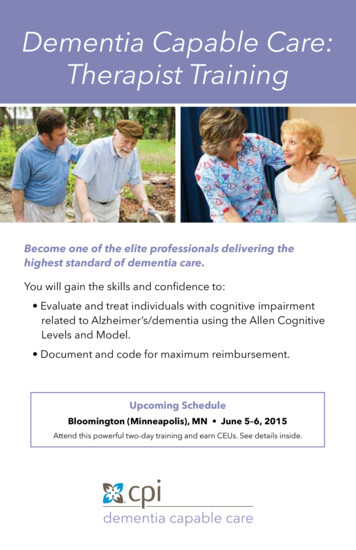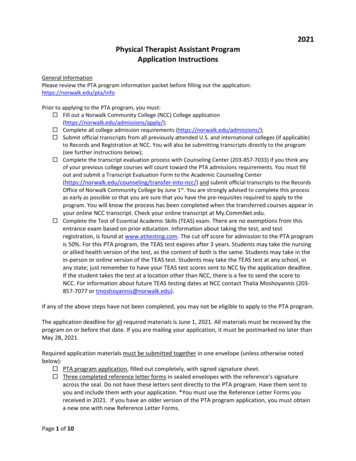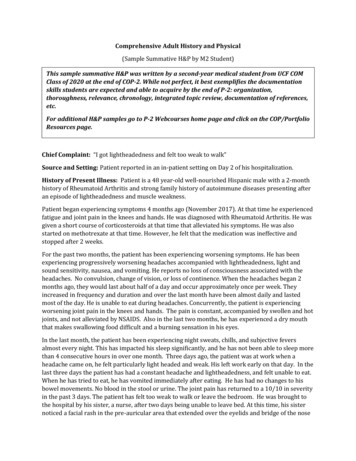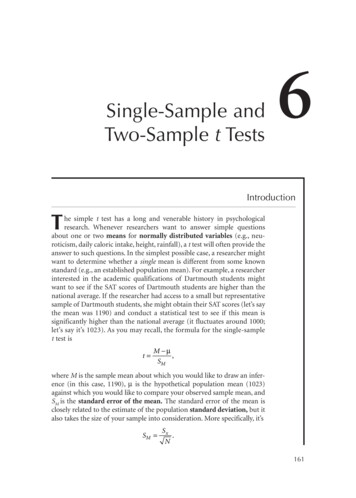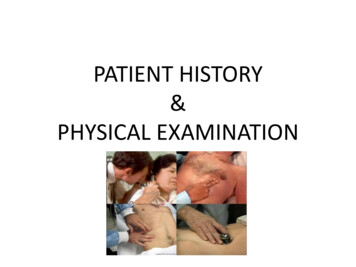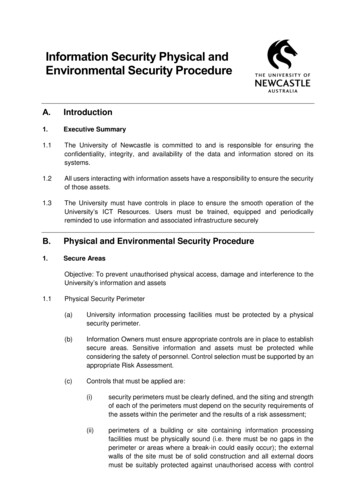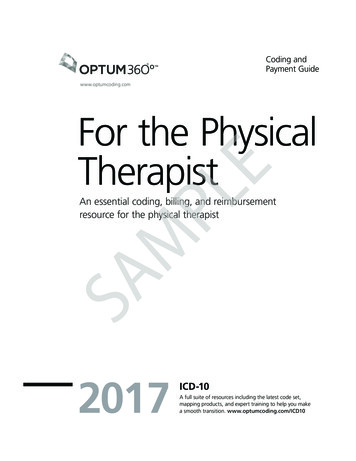
Transcription
Coding andPayment Guidewww.optumcoding.comMPLEFor the PhysicalTherapistSAAn essential coding, billing, and reimbursementresource for the physical therapist2017ICD-10A full suite of resources including the latest code set,mapping products, and expert training to help you makea smooth transition. www.optumcoding.com/ICD10
IntroductionCoding systems grew out of the need for data collection. By having astandard notation for the procedures performed and for the diseases,injuries, and illnesses diagnosed, statisticians could identify effectivetreatments as well as broad practice patterns. Before long, these earlycoding systems emerged as the basis to pay claims. Coding systemsand claim forms have evolved to become the basis of payment forhealth care services. The correct application of codes and knowledge ofpayer policies correlates directly to payment.Other mechanisms involved in getting paid may also includedocumentation of functional deficits, but any translation to a claimform would be payer specific.Coding SystemsSACoding systems seek to answer two questions: what was wrong withthe patient (i.e., the diagnosis or diagnoses) and what was done totreat the patient (i.e., the procedures or services rendered).Under the aegis of the federal government, a three-tiered codingsystem emerged for health care providers and outpatient facilities. ThePhysicians’ Current Procedural Terminology (CPT ) codes reportmedical procedures and services and comprises Level I of the system. Asecond level, known as HCPCS Level II codes, are mainly used toidentify products, supplies, and services that are not included in theCPT codes. Dovetailing with each of these is the InternationalClassification of Diseases, 10th Revision, Clinical Modification(ICD-10-CM) classification system that reports the diagnosis ofillnesses, diseases, and injuries.Further explanations of each of these coding systems follows.HCPCS Level I or CPT CodesCMS, in conjunction with the American Medical Association (AMA), theAmerican Dental Association (ADA), and several other professionalgroups developed, adopted, and implemented a coding systemdescribing services rendered to patients. Known as HCPCS Level I, theCPT coding system is the most commonly used system to reportprocedures and services. Copyright of CPT codes and descriptions isheld by the AMA. This system reports outpatient and provider services.CPT codes predominantly describe medical services and procedures,and are adapted to provide a common billing language that providers 2016 Optum360, LLCThe AMA’s CPT Editorial Panel reviews the coding system and adds,revises, and deletes codes and descriptions. The panel acceptsinformation and feedback from providers about new codes andrevisions to existing codes that could better reflect the providedservice or procedure. The American Physical Therapy Association(APTA) is represented on the Health Care Professional AdvisoryCommittee (HCPAC) for both the AMA CPT Editorial Panel and the AMARelative Value Update Committee (RUC). The CPT HCPACrepresentative provides input for the development and revision of CPTcodes, while the RUC HCPAC representative provides input into theestablishment of relative values for the codes.The majority of codes are found in category I of the CPT coding system.These five-digit codes describe procedures and services that arecustomarily performed including those performed by the physicaltherapist.CPT category II codes are supplemental tracking codes that areprimarily used when participating in the Physician Quality ReportingSystem (PQRS) established by Medicare and are intended to aid in thecollection of data about quality of care. Category II codes arealphanumeric, consisting of four digits followed by an F and shouldnever be used in lieu of a category I CPT code. A complete list of thecategory II codes can be found at the AMA website g-insurance/cpt/about-cpt/category-ii-codes.page. More information regarding the PQRS can befound on the CMS website at tient-Assessment-Instruments/PQRS/index.html, and at http://www.apta.org/pqrs.MPLThe administrative simplification provisions of the Health InsurancePortability and Accountability Act (HIPAA) of 1996 required thestandardization of the several hundred health care claim formatspreviously in existence, as well as the establishment of standardizedcode sets for medical data including diagnoses, drugs, procedures,equipment, and supplies. The goal of the national standards is toreduce the administrative encumbrances of the existing system,simplify the way medical claims are paid, reduce costs, and promotethe growth of electronic business in the health care industry.and payers can use for payment purposes. The codes are required forbilling by both private and public insurance carriers, managed carecompanies, and workers’ compensation programs.ECoding systems and claim forms are part of the reality of modernhealth care. This Coding and Payment Guide provides a comprehensiveexplanation of the coding and payment systems used by physicaltherapists. Organized by topics and by numerical procedure codelistings pertinent to physical therapy, it can be used as a coding as wellas a payment resource.Category III of the CPT coding system contains temporary trackingcodes for new and emerging technologies that are meant to aid in thecollection of data on these new services and procedures as well asfacilitate the payment process. However, it should be noted that fewpayers reimburse for emerging technology procedures and services.CPT category III codes consist of four numeric digits followed by a T.Like category II codes, category III codes are released twice a year(January 1 and July I) and can be found on the AMA CPT website insurance/cpt/about-cpt/category-iii-codes.page. RVUs are notassigned for category III codes and payment is made at the discretionof the payer. A service described by a CPT code may eventually becomea category I code, as the efficacy and safety of the service isdocumented and as the category II codes are sunsetted after five yearsand then must be reviewed for continued use as category IIIdescriptors.ICD-10-CM CodesIn response to ICD-9-CM’s shortcomings, new coding systems weredeveloped and soon will be implemented in the United States. TheWorld Health Organization (WHO) created and adopted ICD-10 in 1994and it has been used in much of the world since then. This system is thebasis for the new U.S. diagnosis coding system, International 2015 American Medical Association. All Rights Reserved.1
Procedure CodesCoding and Payment Guide for the Physical Therapist29505-2951529505Application of long leg splint (thigh to ankle or toes)29515Application of short leg splint (calf to foot)Terms To KnowExplanationsplint. Brace or support. 1) dynamic splint: brace that permits movement of anCoding TipsICD-10-CM Diagnostic 61M66.862S97.01XAS97.02XARecurrent dislocation of patella, right kneeRecurrent dislocation of patella, left kneeRecurrent subluxation of patella, right kneeRecurrent subluxation of patella, left kneeChondromalacia patellae, right kneeChondromalacia patellae, left kneeChronic instability of knee, right kneeChronic instability of knee, left kneeRecurrent dislocation, right kneeRecurrent dislocation, left kneeEffusion, right kneeEffusion, left kneeSpontaneous rupture of flexor tendons, right lower legSpontaneous rupture of flexor tendons, left lower legSpontaneous rupture of other tendons, right lower legSpontaneous rupture of other tendons, left lower legCrushing injury of right ankle, initial encounterCrushing injury of left ankle, initial encounterMPLThe code for the initial treatment of a fracture or dislocation includes theapplication, maintenance, and removal of the first cast or traction. SeeApplication of Casts and Strapping in the CPT book in the Surgery section,under Musculoskeletal System. Splint supplies are reported separately, seeHCPCS Level II codes.anatomical structure such as a hand, wrist, foot, or other part of the body after surgeryor injury. 2) static splint: brace that prevents movement and maintains support andposition for an anatomical structure after surgery or injury.EIn 29505, the qualified health care provider applies a long leg splint from thighto the ankle or toes. A long leg posterior splint is used to immobilize a numberof injuries around the knee or ankle. The qualified health care provider wrapscotton bandaging around the involved leg from the upper thigh to the ankleor toes. Plaster strips or fiberglass splint material are applied along the posterioraspect of the leg from the upper thigh to the ankle or toes. After the splintmaterial dries, it is secured into place by an Ace wrap. In 29515, the qualifiedhealth care provider applies a short leg splint from calf to foot. A short legsplint is used to immobilize the ankle. The qualified health care provider wrapscotton bandaging from just below the knee to the toes. Plaster strips orfiberglass splinting material are applied to the posterior of the calf, aroundthe heel, and along the bottom of the foot to the toes. After the splint materialdries, it is secured into place by an Ace wrap.According to CPT guidelines, cast application or strapping (including removal)is only reported as a replacement procedure or when the cast application orstrapping is an initial service performed without a restorative treatment orprocedure. See Application of Casts and Strapping in the CPT book in theSurgery section, under Musculoskeletal System.Documentation TipsUnder the RBRVS payment methodology, supplies that typically are used inthe delivery of a service (such as electrodes) have been included in thecalculation of the practice expense value for the code and should not be billedseparately.SAThe anatomical location, as well as the condition necessitating the treatment,should be clearly identified in the medical record.A dislocation is the traumatic displacement of the bones in any articulatingjoint severe enough to lose normal anatomic relationship. A dislocation(luxation) occurs when the bones completely lose contact with their articulatingsurfaces. A subluxation occurs when there is only a partial loss of contact.Closed dislocation is described by terms such as complete, NOS, partial, simple,and uncomplicated. Open dislocation is described by terms such as compound,infected, and with foreign body. Dislocations not specified as open or closedshould be classified as closed.A sprain is a complete or incomplete tear in any one or more of the ligamentsthat surround and support a joint. A strain is an ill-defined injury caused byoveruse or overextension of the muscles or tendons of a joint.Reimbursement TipsPlease note that this list of associated ICD-10-CM codes is not all-inclusive.The procedure may be performed for reasons other than those listed thatsupport the medical necessity of the service. Only those conditions supportedby the medical record documentation should be reported.Medicare EditsFac RVUNon-Fac 515Modifiers295055150295155150* with documentationN/AN/AMedicare ReferencesN/AN/ANoneThe multiple procedure payment reduction (MPPR) policy applies to thisservice. Under MPPR, when multiple “always therapy” procedures are renderedto the same patient on the same date of service (even in separate sessions),the procedure with the highest practice expense value that day is paid at 100percent, and the practice expense component of the second and subsequenttherapy services is paid at 50 percent. The work and malpractice componentsof the therapy service payment are not reduced. For payers other thanMedicare, the amount of the reduction may vary by payer and by insuranceplan.18CPT 2015 American Medical Association. All Rights Reserved. 2016 Optum360, LLC
Procedure CodesCoding and Payment Guide for the Physical Therapist95831-95834following three modifiers refer only to services provided under plans of carefor physical therapy, occupational therapy, and speech-language pathologyservices, and should only be reported with codes on the list of applicabletherapy codes:95831Muscle testing, manual (separate procedure) with report;extremity (excluding hand) or trunk95832hand, with or without comparison with normal side95833total evaluation of body, excluding handsGN Services delivered under an outpatient speech-language pathology planof care95834total evaluation of body, including handsGO Services delivered under an outpatient occupational therapy plan of careGP Services delivered under an outpatient physical therapy plan of careMuscles or muscle groups are tested for strength. Code 95831 applies tomanually testing the arm, leg, or trunk; 95832 applies to manually testing thehands; 95833 applies to manually testing the body exclusive of the hands;95834 applies to manually testing the body inclusive of the hands.Coding TipsMPLThese codes are not to be reported for every muscle test. Rather, each of thesecodes is to be reported only one time for each extremity or area of the bodydesignated by the code descriptor. Some aspects of manual muscle testingusually are included in the physical therapy evaluation/reevaluation(97001–97002). If reporting 95831–95834, the evaluator is required to preparea signed and documented separate report that identifies the specific musclestested, the grade of strength and scale used to measure, and comparativemuscle grades if applicable. If such a report is not prepared and included inthe medical record as a separate billable procedure, then the appropriateevaluation or reevaluation code (97001–97002) should be used, or 97750 alsocan be used to report manual muscle testing as a separate procedure from anevaluation or re-evaluation.Code 97750 Physical performance test or measurement is an alternate code.When reporting 97750, documentation must include a report of all elementsof the test or measure.Documentation TipsSADocumentation to support 95831–95834 includes a description of the protocolfor the procedure, the specific area(s) of the body being tested/measured, thepurpose of the procedure, and the outcome, as well as impact on theindividual's plan of care. According to the AMA, a grading system that useseither a numeric scale ranging from 0 to 5, or language equivalent to this scalesuch as zero, fair, good, or normal could be used.Examples of examination findings include:Electrophysiologic integrityMuscle strength, power, and enduranceMuscle tensionThese services are considered separate procedures, are usually a componentof a more complex service, and are not identified separately. When performedalone or with other unrelated procedures/services, they may be reported. Ifperformed alone, list the code; if performed with other unrelatedprocedures/services, list the code and append modifier 59 Distinct proceduralservice.These services may be billed in addition to the standard evaluation. Note thatbecause these codes are outside the physical medicine series of codes it isadvisable for the physical therapist to obtain payment information or priorauthorization from the payer before rendering the service.Terms To Knowmyelopathy. Pathological or functional changes in the spinal cord, often resultingfrom nonspecific and noninflammatory lesions.neuropathy. Abnormality, disease, or malfunction of the nerves.separate procedures. Services commonly carried out as a fundamental part ofa total service and, as such, do not usually warrant separate identification. These servicesare identified in CPT with the parenthetical phrase (separate procedure) at the end ofthe description and are payable only when performed alone.ICD-10-CM Diagnostic CodesWhen modifier KX is reported, the medical record documentation shouldinclude:The patient’s complaintsThe condition that indicates why the evaluation was necessaryThe description of any complex situations that directly and substantiallyimpact the patient’s treatmentReimbursement TipsThis service is considered a “sometimes-therapy” service and is subject to theMedicare outpatient physical therapy cap when performed by the physicaltherapist. The following modifiers are used to identify therapy services, whetheror not the financial limitations are in effect, although the common workingfile (CWF) does track the financial limitation using the therapy modifiers. The50There is a two-tiered exceptions process to the outpatient therapy caps: anautomatic exceptions process and a medical review exceptions process. Underthe automatic exceptions process, therapists must append reported codeswith modifier KX when services will exceed the therapy cap, which is 1,940for 2016. Services above the threshold initially are approved without medicalreview, but still are subject to review by the Medicare administrative contractor.Modifier KX is added to other required modifiers (GN for speech-languagepathology services, GO for occupational therapy services, and GP for physicaltherapy services). The medical review exceptions process is required at the 3,700 threshold. Under this process, CMS determine which therapy servicesto review by considering factors that include: (1) providers with patterns ofaberrant billing practices compared with their peers; (2) providers with a highclaims denial percentage or who are less compliant with applicable Medicareprogram requirements; and (3) newly enrolled 60.1G60.2G60.3G60.9G61.0G61.1G61.81Carpal tunnel syndrome, right upper limbCarpal tunnel syndrome, left upper limbIntercostal neuropathyMononeuritis multiplexHereditary motor and sensory neuropathyRefsum's diseaseNeuropathy in association with hereditary ataxiaIdiopathic progressive neuropathyHereditary and idiopathic neuropathy, unspecifiedGuillain-Barre syndromeSerum neuropathyChronic inflammatory demyelinating polyneuritisCPT 2015 American Medical Association. All Rights Reserved. 2016 Optum360, LLC
Coding and Payment Guide for the Physical .644M79.645M79.7R25.2R29.5R41.4 2016 Optum360, S64.492AS64.492DInjury of radial nerve at wrist and hand level of right arm, initialencounterInjury of radial nerve at wrist and hand level of right arm,subsequent encounterInjury of radial nerve at wrist and hand level of left arm, initialencounterInjury of radial nerve at wrist and hand level of left arm,subsequent encounterInjury of digital nerve of right thumb, initial encounterInjury of digital nerve of right thumb, subsequent encounterInjury of digital nerve of left thumb, initial encounterInjury of digital nerve of left thumb, subsequent encounterInjury of digital nerve of right index finger, initial encounterInjury of digital nerve of right index finger, subsequent encounterInjury of digital nerve of left index finger, initial encounterInjury of digital nerve of left index finger, subsequent encounterInjury of digital nerve of right middle finger, initial encounterInjury of digital nerve of right middle finger, subsequentencounterInjury of digital nerve of left middle finger, initial encounterInjury of digital nerve of left middle finger, subsequent encounterInjury of digital nerve of right ring finger, initial encounterInjury of digital nerve of right ring finger, subsequent encounterInjury of digital nerve of left ring finger, initial encounterInjury of digital nerve of left ring finger, subsequent encounterInjury of digital nerve of right little finger, initial encounterInjury of digital nerve of right little finger, subseq
explanation of the coding and payment systems used by physical therapists. Organized by topics and by numerical procedure code listings pertinent to physical therapy, it can be used as a coding as well as a payment resource. Coding syst
